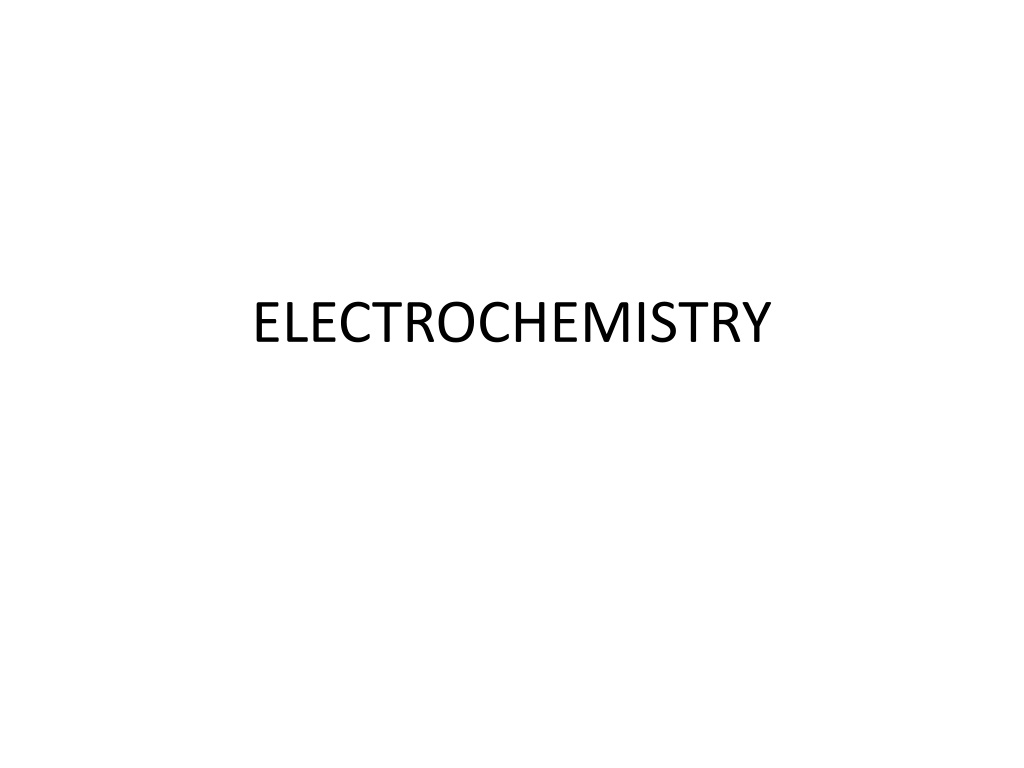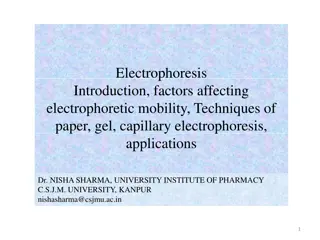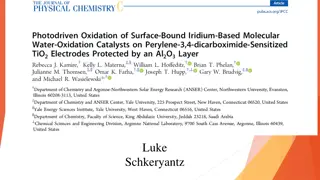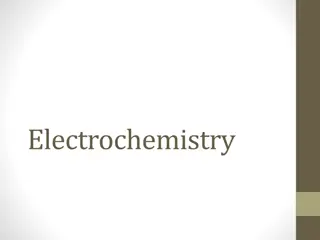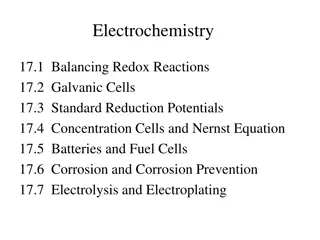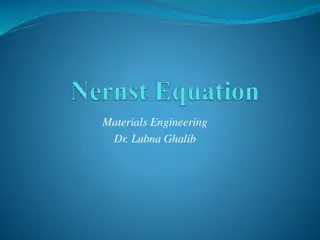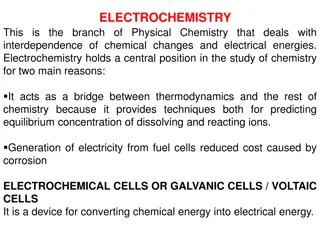Understanding Electrochemistry: Principles and Applications
Electrochemistry is a branch of chemistry focusing on electricity generation from spontaneous chemical reactions and utilizing electrical energy for non-spontaneous transformations. It encompasses important concepts like electrolytes, electrode potential, electrochemical cells, salt bridges, and the role of the Standard Hydrogen Electrode. The field's significance lies in metal production, electroplating, metal purification, and battery technology. Explore the world of electrochemistry through its various applications and fundamental principles.
Download Presentation

Please find below an Image/Link to download the presentation.
The content on the website is provided AS IS for your information and personal use only. It may not be sold, licensed, or shared on other websites without obtaining consent from the author. Download presentation by click this link. If you encounter any issues during the download, it is possible that the publisher has removed the file from their server.
E N D
Presentation Transcript
INTRODUCTION .Electrochemistry is that branch of chemistry which deals with the study of production of electricity from energy released during spontaneous chemical reactions and the use of Electrical energy to bring about non- spontaneous chemical transformations.
IMPORTANCE OF ELECTROCHEMISTRY Importance of Electrochemistry 1. Production of metals like Na, Mg. Ca and Al. 2. Electroplating. 3. Purification of metals. 4. Batteries and cells used in various instruments.
ELECTROLYTES Electrolytes are of two types: 1. Strong electrolytes The electrolytes that completely dissociate or ionise into ions are called strong electrolytes. e.g., HCl, NaOH, K2SO4 2. Weak electrolytes The electrolytes that dissociate partially (ex < 1) are called weak electrolytes, e.g., CH3COOH, H2CO3, NH4OHH2S, etc.
ELECTROCHEMICAL AND ELECTROLYTIC CELL In electrochemical cell electric current is produced by the redox reaction taking place inside the cell, eg. Galvanic cell or Voltaic cell In electrolytic cell the chemical reaction inside the cell is caused due to external electric current. In electrochemical cell anode is vely charged whereas reverse is true for electrolytic cell.
SALT BRIDGE Function of salt bridge 1. It completes the circuit and allows the flow of current. 2. It maintains the electrical neutrality on both sides. Salt-bridge generally contains solution of strong electrolyte such as KNO3, KCl etc. KCI is preferred thebecause transport numbers of K+ and Cl-are almost same.
Electrode Potential When an electrode is in contact with the solution of its ions in a half-cell, it has a tendency to lose or gain electrons which is known as electrode potential. It is expressed in volts. It is an intensive property, i.e., independent of the amount of species in the reaction.
Standard Hydrogen Electrode Standard hydrogen electrode (SHE) Standard hydrogen electrode (SHE). also known as normal hydrogen electrode (NHE), consists of platinum wire, carrying platinum foil coated with finely divided platinum black. The wire is sealed into a glass tube. placed in beaker containing 1 M HCl. The hydrogen gas at 1 atm pressure is bubbled through the solution at 298K. Half-cell is
Molar Conductivity The conductivity of all the ions produced when 1 mole of an electrolyte is dissolved in V mL of solution is known as molar conductivity. It is related to specific conductance as m = (k x 1000/M) where. M = molarity. It units are -1 cm2 mol-1 or S cm2 mol-1. Equivalent conductivity
ELECTROLYSIS It is the process of decomposition of an electrolyte when electric current is passed through either its aqueous solution or molten state, 1. In electrolytic cell both oxidation and reduction takes place in the same cell. 2. Anode is positively charged and cathode is negatively charged, In electrolytic cell. 3. During electrolysis of molten electrolyte, cations are liberated at cathode. while anions at the anode 4. When two or more ions compete at the electrodes. the ion with higher reductionpotential gets liberated at the cathode while the ion with lower reduction potential at the anode
How to predict the products of electrolysis When an aqueous solution of an electrolyte is electrolysed, if the cation has higher reduction potential than water (-0.83 V), cation is liberated at the cathode (e.g.. in the electrolysis of copper and silver salts) otherwise H2 gas is liberated due to reduction of water (e.g., in the electrolysis of K, Na, Ca salts, etc.) Similarly if anion has higher oxidation potential than water(- 1.23 V), anion is liberated (e.g., Br- ), otherwise O2 gas is liberated due to oxidation of water(e.g., in caseof F-, aqueous solution of Na2SO4 as oxidation potential of SO42-IS -0.2 V Discharge potential is defined as the minimum potential that must be applied acrosstheelectrodes to bring about the electrolysis and subsequent discharge of the ion on the electrode
FARADAYS LAW OF ELECTROLYSIS 1. First law The amount of the substance deposited or liberated at cathode directly proportional to the quantity of electricity passed through electrolyte. W I x t = I x t x Z = Q x Z I current in amp, t = time in sec, Q = quantity of charge (coulomb) Z is a constant known as electrochemical equivalent. When I = 1 amp, t = 1 sec then Q = 1 coulomb, then w = Z. Thus, electrochemical equivalent I the amount of the substance deposited or liberated by passing 1A current for 1 sec (i.e.. 1 coulomb, I x t = Q)
2. Second law When the same quantity of electricity is passed through different electrolytes. the amounts of the substance deposited or liberated at the electrodes arc directly proportional to theirequivalent weights. Hence, electrochemical equivalent equivalent weight.
BATTERIES These are source of electrical energy which may have one or more cells connected in series.For a good quality battery it should be reasonably light. compact and its voltage should notvary appreciably during its use.
PRIMARY BATTERIES In the primary batteries. the reaction occurs only once and after use over a period of time battery becomes dead and cannot be reused again
SECONDARY BATTRIES Secondary Batteries These cells can be recharged and can be used again and again, e.g., (i) Lead Storage battery Anode-Spongy lead Cathode-Grid of lead packed with PbO2 Electrolyte-38% H2SO4 by mass When recharged the cell reactions are reversed.
FUEL CELLS Galvanic cells which use energy of combustion of fuels like H2, CH4, CH3OH, etc., as the source to produce electrical energy are called fuel cells. The fuel cells are pollution free and have high efficiency.
CORROSION Slow formation of undesirable compounds such as oxides, sulphides or carbonates at the surface of metals by reaction with moisture and other atmospheric gases is known as corrosion. Factors Affecting Corrosion 1. Reactivity of metals 2. Presence of moisture and atmospheric gases like CO2, SO2, etc. 3. Presence of impurities 4. Strains in the metal
